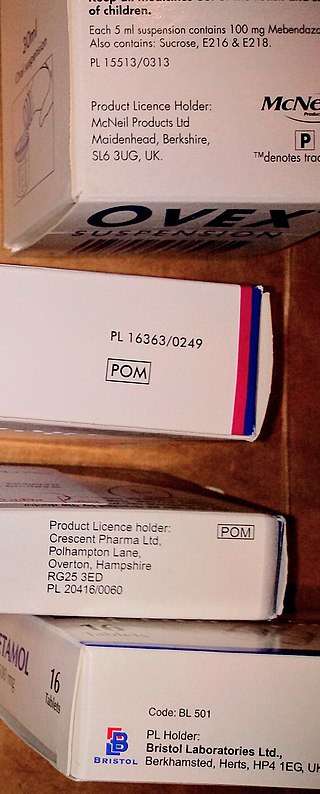Related Research Articles

The United States Food and Drug Administration is a federal agency of the Department of Health and Human Services. The FDA is responsible for protecting and promoting public health through the control and supervision of food safety, tobacco products, caffeine products, dietary supplements, prescription and over-the-counter pharmaceutical drugs (medications), vaccines, biopharmaceuticals, blood transfusions, medical devices, electromagnetic radiation emitting devices (ERED), cosmetics, animal foods & feed and veterinary products.
A trademark is a word, phrase, or logo that identifies the source of goods or services. Trademark law protects a business' commercial identity or brand by discouraging other businesses from adopting a name or logo that is "confusingly similar" to an existing trademark. The goal is to allow consumers to easily identify the producers of goods and services and avoid confusion.

A generic drug is a pharmaceutical drug that contains the same chemical substance as a drug that was originally protected by chemical patents. Generic drugs are allowed for sale after the patents on the original drugs expire. Because the active chemical substance is the same, the medical profile of generics is equivalent in performance compared to their performance at the time when they were patented drugs. A generic drug has the same active pharmaceutical ingredient (API) as the original, but it may differ in some characteristics such as the manufacturing process, formulation, excipients, color, taste, and packaging.

A prescription drug is a pharmaceutical drug that is permitted to be dispensed only to those with a medical prescription. In contrast, over-the-counter drugs can be obtained without a prescription. The reason for this difference in substance control is the potential scope of misuse, from drug abuse to practicing medicine without a license and without sufficient education. Different jurisdictions have different definitions of what constitutes a prescription drug.
Merck KGaA v. Integra Lifesciences I, Ltd., 545 U.S. 193 (2005), is a United States Supreme Court case with ramifications for patent law. The dispute dates to approximately 1996 and centers on a federal law known as the "FDA safe harbor".

In patent law, the research exemption or safe harbor exemption is an exemption to the rights conferred by patents, which is especially relevant to drugs. According to this exemption, despite the patent rights, performing research and tests for preparing regulatory approval, for instance by the FDA in the United States, does not constitute infringement for a limited term before the end of patent term. This exemption allows generic manufacturers to prepare generic drugs in advance of the patent expiration.

Triamterene is a potassium-sparing diuretic often used in combination with thiazide diuretics for the treatment of high blood pressure or swelling. The combination with hydrochlorothiazide, is known as hydrochlorothiazide/triamterene.
The USA is considered to have the most favorable legal regime for inventors and patent owners in the World. Under United States law, a patent is a right granted to the inventor of a (1) process, machine, article of manufacture, or composition of matter, (2) that is new, useful, and non-obvious. A patent is the right to exclude others, for a limited time from profiting of a patented technology without the consent of the patent-holder. Specifically, it is the right to exclude others from: making, using, selling, offering for sale, importing, inducing others to infringe, applying for an FDA approval, and/or offering a product specially adapted for practice of the patent.
Mylan N.V. was a global generic and specialty pharmaceuticals company. In November 2020, Mylan merged with Upjohn, Pfizer's off-patent medicine division, to form Viatris. Previously, the company was domiciled in the Netherlands, with principal executive offices in Hatfield, Hertfordshire, UK and a "Global Center" in Canonsburg, Pennsylvania, US.

The Drug Price Competition and Patent Term Restoration Act, informally known as the Hatch-Waxman Act, is a 1984 United States federal law that established the modern system of generic drug regulation in the United States. The Act's two main goals are to facilitate entry of generic drugs into the market and to compensate the original drug developers for regulatory delays by the Food and Drug Administration. It is generally believed that the Act accomplished both goals: encouraging development of new medications and accelerating market entry of generics.
Evergreening is any of various legal, business, and technological strategies by which producers extend the lifetime of their patents that are about to expire in order to retain revenues from them. Often the practice includes taking out new patents, or by buying out or frustrating competitors, for longer periods of time than would normally be permissible under the law. Robin Feldman, a law professor at UC Law SF and a leading researcher in intellectual property and patents, defines evergreening as "artificially extending the life of a patent or other exclusivity by obtaining additional protections to extend the monopoly period."
In the United States, a valid patent provides its proprietor with the right to exclude others from practicing the invention claimed in that patent. A person who practices that invention without the permission of the patent holder infringes that patent.
The United States is the largest grower of commercial crops that have been genetically engineered in the world, but not without domestic and international opposition.
Approved Drug Products with Therapeutic Equivalence Evaluations, commonly known as the Orange Book, is a publication produced by the United States Food and Drug Administration (FDA), as required by the Drug Price and Competition Act.
Inwood Laboratories Inc. v. Ives Laboratories, Inc., 456 U.S. 844 (1982), is a United States Supreme Court case, in which the Court confirmed the application of and set out a test for contributory trademark liability under § 32 of the Lanham Act.
The Food and Drug Administration is a federal agency of the United States, formed in 1930.
Reverse payment patent settlements, also known as "pay-for-delay" agreements, are a type of agreement that has been used to settle pharmaceutical patent infringement litigation, in which the company that has brought the suit agrees to pay the company it sued. That is, the patent holder pays the alleged infringer to stop its alleged infringing activity for some period of time and to stop disputing the validity of the patent. These agreements are distinct from most patent settlements, which usually involve the alleged infringer paying the patent holder.
Abbott v. Sandoz, 566 F.3d 1282, was a US patent law case argued before the United States Court of Appeals for the Federal Circuit that established a bright-line ruling regarding claims of patent infringement relating to disagreements over so-called “product-by-process” claims. The case was decided on May 18, 2009.
FTC v. Actavis, Inc., 570 U.S. 136 (2013), was a United States Supreme Court decision in which the Court held that the FTC could make an antitrust challenge under the rule of reason against a so-called pay-for-delay agreement, also referred to as a reverse payment patent settlement. Such an agreement is one in which a drug patentee pays another company, ordinarily a generic drug manufacturer, to stay out of the market, thus avoiding generic competition and a challenge to patent validity. The FTC sought to establish a rule that such agreements were presumptively illegal, but the Court ruled only that the FTC could bring a case under more general antitrust principles permitting a defendant to assert justifications for its actions under the rule of reason.
Mutual Pharmaceutical Co. v. Bartlett, 570 U.S. 472 (2013), is a decision by the Supreme Court of the United States holding that generic drug manufactures cannot be held liable under state law for not adequately labeling medication when federal law prohibits them from changing the label from the original brand name drug.
References
- 1 2 3 4 5 Roche Products, Inc. v. Bolar Pharmaceutical Co., 733F.2d858 (Fed. Cir.1984).
- ↑ Kankanala, Kalyan C. (2007). Genetic Patent Law and Strategy. Manupatra. p. 139. ISBN 978-81-89542-26-9.
- ↑ Cook, Anna (1998). How Increased Competition from Generic Drugs Has Affected Prices and Returns in the Pharmaceutical Industry. Congress of the United States, Congressional Budget Office. ISBN 9780160496813.
- ↑ Krulwich, Andrew S. (1985). "Statutory Reversal of Roche v. Bolar: What You See Is Only the Beginning of What You Get". Food, Drug, Cosmetic Law Journal. 40 (4): 519–525. ISSN 0015-6361. JSTOR 26658803.
- ↑ Jeffrey I. D. Lewis, "Declaratory Judgments of Patent Infringement: What They Forgot about Drug Applications," Federal Circuit Bar Journal 7, no. 1 (Spring 1997): 35-54
- ↑ Oke, Emmanuel Kolawole (November 2015). "Expanding the reach of India's 'Bolar' exemption". Queen Mary Journal of Intellectual Property. 5 (4): 509–515. doi:10.4337/qmjip.2015.04.08.
- ↑ Barden, Marina (August 31, 2008). "EU Bolar exemption is not so simple". Managing Intellectual Property. Retrieved August 19, 2020.